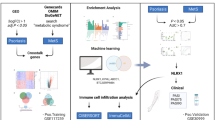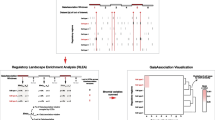Abstract
Genome-wide association studies (GWASs) have discovered >50 risk loci for type 1 diabetes (T1D). However, those variations only have modest effects on the genetic risk of T1D. In recent years, accumulated studies have suggested that gene–gene interactions might explain part of the missing heritability. The purpose of our research was to identify potential and novel risk genes for T1D by systematically considering the gene–gene interactions through network analyses. We carried out a novel system network analysis of summary GWAS statistics jointly with transcriptomic gene expression data to identify some of the missing heritability for T1D using weighted gene co-expression network analysis (WGCNA). Using WGCNA, seven modules for 1852 nominally significant (P ≤ 0.05) GWAS genes were identified by analyzing microarray data for gene expression profile. One module (tagged as green module) showed significant association (P ≤ 0.05) between the module eigengenes and the trait. This module also displayed a high correlation (r = 0.45, P ≤ 0.05) between module membership (MM) and gene significant (GS), which indicated that the green module of co-expressed genes is of significant biological importance for T1D status. By further describing the module content and topology, the green module revealed a significant enrichment in the “regulation of immune response” (GO:0050776), which is a crucially important pathway in T1D development. Our findings demonstrated a module and several core genes that act as essential components in the etiology of T1D possibly via the regulation of immune response, which may enhance our fundamental knowledge of the underlying molecular mechanisms for T1D.




Similar content being viewed by others
References
Atkinson M, Eisenbarth G, Michels A. Type 1 diabetes. Lancet. 2014;383:69–82.
Sherwin R, Jastreboff AM. Year in diabetes 2012: the diabetes tsunami. J Clin Endocrinol Metab. 2012;97:4293–301.
Pociot F, Lernmark Å. Genetic risk factors for type 1 diabetes. Lancet. 2016;387:2331–9.
Groop L, Pociot F. Genetics of diabetes – are we missing the genes or the disease? Mol Cell Endocrinol. 2014;382:726–39.
Kyvik KO, Green A, Beck-Nielsen H. Concordance rates of insulin dependent diabetes mellitus: a population based study of young Danish twins. BMJ. 1995;311:913–7.
Clayton DG. Prediction and interaction in complex disease genetics: experience in type 1 diabetes. PLoS Genet. 2009;5:e1000540.
Bradfield JP, Qu HQ, Wang K, Zhang H, Sleiman PM, Kim CE, et al. A genome-wide meta-analysis of six type 1 diabetes cohorts identifies multiple associated loci. PLoS Genet. 2011;7:e1002293.
Barrett JC, Clayton DG, Concannon P, Akolkar B, Cooper JD, Erlich HA, et al. Genome-wide association study and meta-analysis find that over 40 loci affect risk of type 1 diabetes. Nat Genet. 2009;41:703–7.
Manolio TA, Collins FS, Cox NJ, Goldstein DB, Hindorff LA, Hunter DJ, et al. Finding the missing heritability of complex diseases. Nature. 2009;461:747–53.
Li M, Wei C, Wen Y, Wang T, Lu Q. Detecting gene-gene interactions associated with multiple complex traits with U-statistics. Curr Genom. 2016;17:403–15.
Farber CR. Systems-level analysis of genome-wide association data. G3 (Bethesda). 2013;3:119–29.
Langfelder P, Horvath S. WGCNA: an R package for weighted correlation network analysis. BMC Bioinform. 2008;9:559.
He H, Zhang L, Li J, Wang YP, Zhang JG, Shen J, et al. Integrative analysis of GWASs, human protein interaction, and gene expression identified gene modules associated with BMDs. J Clin Endocrinol Metab. 2014;99:E2392–9.
Chen Y, Guo Y, He H, Lin X, Wang X, Zhou R, et al. Integrative analysis of genomics and transcriptomedata to identify potential functional genes of BMDs in females. J Bone Mineral Res. 2016;31:1041–9.
Riquelme Medina I, Lubovac-Pilav Z. Gene co-expression network analysis for identifying modules and functionally enriched pathways in type 1 diabetes. PLoS One. 2016;11:e0156006.
Noble JA. Immunogenetics of type 1 diabetes: a comprehensive review. J Autoimmun. 2015;64:101–12.
Lehuen A, Diana J, Zaccone P, Cooke A. Immune cell crosstalk in type 1 diabetes. Nat Rev Immunol. 2010;10:501–13.
Axelsson S, Faresjo M, Hedman M, Ludvigsson J, Casas R. Cryopreserved peripheral blood mononuclear cells are suitable for the assessmentof immunological markers in type 1 diabetic children. Cryobiology. 2008;57:201–8.
Mishra A, Macgregor S. VEGAS2: software for more flexible gene-based testing. Twin Res Human Genet. 2015;18:86–91.
Chimen M, McGettrick HM, Apta B, Kuravi SJ, Yates CM, Kennedy A, et al. Homeostatic regulation of T cell trafficking by a B cell–derived peptide is impaired in autoimmune and chronic inflammatory disease. Nat Med. 2015;21:467–75.
Qing Y, Zhou J, Zhao M, Xie W, Yang Q, Xing Y, et al. Altered expression of TPP1 in fibroblast-like synovial cells might be involved in the pathogenesis of rheumatoid arthritis. Rheumatol Int. 2012;32:2503–10.
Kiani AK, Jahngir S, John P, Bhatti A, Zia A, Wang X, et al. Genetic link of type 1 diabetes susceptibility loci with rheumatoid arthritis in Pakistani patients. Immunogenetics. 2015;67:277–82.
Martinez P, Gomez-Lopez G, Garcia F, Mercken E, Mitchell S, Flores JM, et al. RAP1 protects from obesity through its extratelomeric role regulating gene expression. Cell Rep. 2013;3:2059–74.
Babaei-Jadidi R, Karachalias N, Ahmed N, Battah S, Thornalley PJ. Prevention of incipient diabetic nephropathy by high-dose thiamine and benfotiamine. Diabetes. 2003;52:2110–20.
Hammes H, Du X, Edelstein D, Taguchi T, Matsumura T, Ju Q, et al. Benfotiamine blocks three major pathways of hyperglycemic damage and prevents experimental diabetic retinopathy. Nat Med. 2003;9:294–9.
Burton PR, Clayton DG, Cardon LR, Craddock N, Deloukas P, Duncanson A, et al. Genome-wide 414 association study of 14,000 cases of seven common diseases and 3,000 shared controls. Nature. 2007;447:661–78.
Hoyne GF. Mechanisms that regulate peripheral immune responses to control organ-specific autoimmunity. Clin Dev Immunol. 2011;2011:1–9.
Reddy MPL, Wang H, Liu S, Bode B, Reed JC, Steed RD, et al. Association between type 1 diabetes and GWAS SNPs in the southeast US Caucasian population. Genes Immun. 2011;12:208–12.
Owerbach D, Pina L, Gabbay KH. A 212-kb region on chromosome 6q25 containing the TAB2 gene is associated with susceptibility to type 1 diabetes. Diabetes. 2004;53:1890–3.
Tomita T. Apoptosis of pancreatic beta-cells in type 1 diabetes. Bosn J Basic Med Sci. 2017;17:183–93.
Evangelou M, Smyth DJ, Fortune MD, Burren OS, Walker NM, Guo H, et al. A method for gene-based pathway analysis using genome wide association study summary statistics reveals nine new type 1 diabetes associations. Genet Epidemiol. 2014;38:661–70.
Glawe JD, Patrick DR, Huang M, Sharp CD, Barlow SC, Kevil CG. Genetic deficiency of Itgb2 or ItgaL prevents autoimmune diabetes through distinctly different mechanisms in NOD/LtJ mice. Diabetes. 2009;58:1292–301.
Sironi M, Guerini FR, Agliardi C, Biasin M, Cagliani R, Fumagalli M, et al. An evolutionary analysis of RAC2 identifies haplotypes associated with human autoimmune diseases. Mol Biol Evol. 2011;28:3319–29.
Onengut-Gumuscu S, Chen W, Burren O, Cooper NJ, Quinlan AR, Mychaleckyj JC, et al. Fine mapping of type 1 diabetes susceptibility loci and evidence for colocalization of causal variants with lymphoid gene enhancers. Nat Genet. 2015;47:381–6.
Eizirik DL, Colli ML, Ortis F. The role of inflammation in insulitis and β-cell loss in type 1 diabetes. Nat Rev Endocrinol. 2009;5:219–26.
Jeanclos E, Krolewski A, Skurnick J, Kimura M, Aviv H, Warram JH, et al. Shortened telomere length in white blood cells of patients with IDDM. Diabetes. 1998;47:482–6.
Shalev I. Early life stress and telomere length: investigating the connection and possible mechanisms: a critical survey of the evidence base, research methodology and basic biology. Bioessays. 2012;34:943–52.
Pai SY, Kim C, Williams DA. Rac GTPases in human diseases. Dis Markers. 2010;29:177–87.
Yu H, Leitenberg D, Li B, Flavell RA. Deficiency of small GTPase Rac2 affects T cell activation. J Exp Med. 2001;194:915–26.
Ramaswamy M, Dumont C, Cruz AC, Muppidi JR, Gomez TS, Billadeau DD, et al. Cutting edge: Rac GTPases sensitize activated T cells to die via Fas. J Immunol. 2007;179:6384–8.
Mustelin T, Vang T, Bottini N. Protein tyrosine phosphatases and the immune response. Nat Rev Immunol. 2005;5:43–57.
Salmond RJ, Alexander DR. SHP2 forecast for the immune system: fog gradually clearing. Trends Immunol. 2006;27:154–60.
Giri H, Muthuramu I, Dhar M, Rathnakumar K, Ram U, Dixit M. Protein tyrosine phosphatase SHP2 mediates chronic insulin-induced endothelial inflammation. Arterioscler Thromb Vasc Biol. 2012;32:1943–50.
Kaizer EC, Glaser CL, Chaussabel D, Banchereau J, Pascual V, White PC. Gene expression in peripheral blood mononuclear cells from children with diabetes. J Clin Endocrinol Metab. 2007;92:3705–11.
Yang M, Ye L, Wang B, Gao J, Liu R, Hong J, et al. Decreased miR-146 expression in peripheral blood mononuclear cells is correlated with ongoing islet autoimmunity in type 1 diabetes patients. J Diabetes. 2015;7:158–65.
American Diabetes Association. Diagnosis and classification of diabetes mellitus. Diabetes Care. 2011;34(Suppl 1):S62–9.
Hu Z, Snitkin ES, DeLisi C. VisANT: an integrative framework for networks in systems biology. Brief Bioinform. 2008;9:317–25.
Hillenmeyer S, Davis LK, Gamazon ER, Cook EH, Cox NJ, Altman RB. STAMS: STRING-assisted module search for genome wide association studies and application to autism. Bioinformatics. 2016;32:3815–22.
Acknowledgements
This work was partially supported or benefited by the National Institutes of Health Grants [R01 315 AR069055, U19 AG055373, R01 MH104680, R01AR059781, and P20 GM109036]; the Edward G. Schlieder Endowment fund from Tulane University; the National Natural Science Foundation of China [81302228]; the Foundation for P Pearl River Nova program of Guangzhou [2014J2200034] and the Technological Innovation Project of Foshan [2017AG100102].
Author information
Authors and Affiliations
Corresponding author
Ethics declarations
Conflict of interest
The authors declare that they have no conflict of interest.
Electronic supplementary material
Rights and permissions
About this article
Cite this article
Lu, JM., Chen, YC., Ao, ZX. et al. System network analysis of genomics and transcriptomics data identified type 1 diabetes-associated pathway and genes. Genes Immun 20, 500–508 (2019). https://doi.org/10.1038/s41435-018-0045-9
Received:
Revised:
Accepted:
Published:
Issue Date:
DOI: https://doi.org/10.1038/s41435-018-0045-9
- Springer Nature Limited
This article is cited by
-
Elucidate multidimensionality of type 1 diabetes mellitus heterogeneity by multifaceted information
Scientific Reports (2021)
-
A key genomic signature associated with lymphovascular invasion in head and neck squamous cell carcinoma
BMC Cancer (2020)
-
The Genetic Contribution to Type 1 Diabetes
Current Diabetes Reports (2019)




